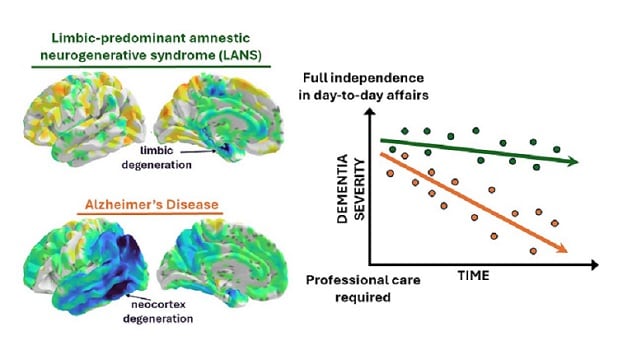Aug. 30, 2024
Predominant limbic degeneration has been associated with various underlying etiologies. But no such neurological syndrome has been defined. Mayo Clinic researchers have proposed clinical criteria for a condition that they term limbic-predominant amnestic neurodegenerative syndrome (LANS). It is highly associated with limbic-predominant age-related TDP-43 encephalopathy along with other, less common pathological entities. The criteria were published in a 2024 issue of Brain Communications.
 Comparación entre síndrome neurodegenerativo amnésico con predominio límbico y enfermedad de Alzheimer
Comparación entre síndrome neurodegenerativo amnésico con predominio límbico y enfermedad de Alzheimer
Las imágenes de cerebros en ambas afecciones resaltan las zonas de degeneración cerebral (azul), con síndrome neurodegenerativo amnésico con predominio límbico, que afecta sobre todo las regiones límbicas y una enfermedad de Alzheimer típica que afecta principalmente la neocorteza. El gráfico ilustra la gravedad de la demencia a lo largo del tiempo, lo cual indica que las personas con síndrome neurodegenerativo amnésico con predominio límbico mantienen su independencia en las actividades diarias por más tiempo, en comparación con los pacientes con enfermedad de Alzheimer típica.
"This endeavor is critical to distinguish predominant limbic degeneration syndromes from those originating from neocortical degeneration, which might differ in underlying etiology, disease course and therapeutic needs," says David T. Jones, M.D., a neurologist at Mayo Clinic in Rochester, Minnesota. "Our criteria can clarify the different etiologies of progressive amnesia that present in older age and guide diagnosis, prognosis, treatment and clinical trials."
The LANS criteria include:
- Older age at evaluation.
- Mild clinical syndrome.
- Disproportionate hippocampal atrophy.
- Impaired semantic memory.
- Limbic hypometabolism.
- Absence of cortical degeneration.
- Low likelihood of neocortical tau.
The researchers used clinical, imaging and biomarker data to validate the criteria's associations with clinical and pathological outcomes of postmortem examinations. Those examinations were performed on specimens from members of the Mayo Clinic Study of Aging and the Alzheimer's Disease Neuroimaging Initiative cohorts. The LANS criteria were applied to individuals in those cohorts who had Alzheimer's disease neuropathological change, limbic-predominant age-related TDP-43 encephalopathy or both pathologies at autopsy.
"The criteria effectively categorized these cases," Dr. Jones says. "Individuals with Alzheimer's disease had the lowest likelihood of LANS, limbic-predominant age-related TDP-43 encephalopathy patients had the highest likelihood, and patients with both pathologies had intermediate likelihood."
The researchers note that detecting causes for predominant amnestic symptoms is highly relevant amid the development of disease-modifying therapies. "Given that several non-Alzheimer's disease etiologies are associated with limbic degeneration, it's important to prevent patients from being inadvertently treated with inappropriate therapies — and begin to find the right ones," Dr. Jones says.
For more information
Corriveau-Lecavalier N, et al. Clinical criteria for a limbic-predominant amnestic neurodegenerative syndrome. Brain Communications. 2024;6:fcae183.
Refer a patient to Mayo Clinic.